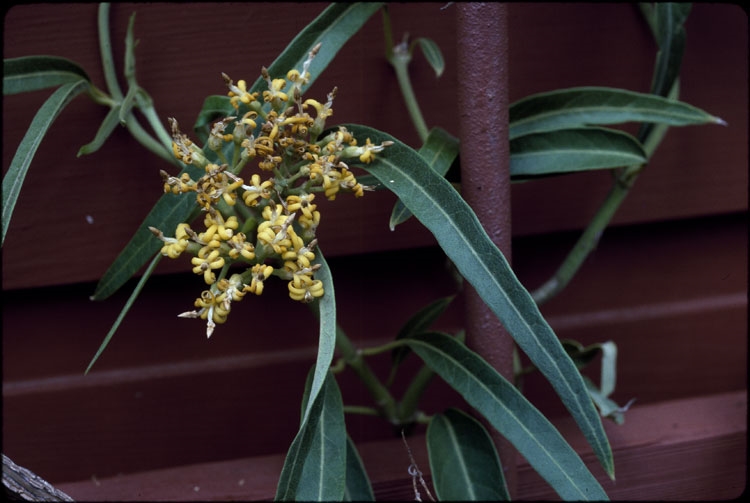Australian Tropical Rainforest Plants - Online edition
Parsonsia eucalyptophylla F.Muell.
Mueller, F.J.H. von (1861), Fragmenta Phytographiae Australiae 2(16): 159. Type: "In virgultis planitierum (Brigalow Scrub dictis) et in montibus dumosis prope tractum Peak Range, flumina Suttor, Dawson et Mackenzie, F.M.; prope oppidum Warwick et in montibus Barrier Range. Dr. Beckler."
Vinetree, Woodbine, Monkey Vine, Gargaloo
A woody vine with stem diameter up to 10 cm. Stem exudate clear and watery. Young stems densely hairy becoming hairless.
Leaves simple, opposite. Petiole 8-30 mm long, channelled above. Juvenile leaf blades ovate, 2-5 cm long, base cordate. Adult leaves linear to narrowly lanceolate, 8-24 cm long, 0.5-2 cm wide, base gradually attenuate, margins entire, apex subulate. Basal lamina colleters absent. Lateral veins about 22-30 pairs. Upper surface dull green and hairless or minutely hairy, lower surface paler and minutely hairy. Domatia absent. Small stipule-like glands usually present on the twigs between the petiole bases and in axils of leaves, linear, 0.5-0.8 mm long.
Inflorescence axillary and terminal, flowers arranged in a panicle of corymbose cymes (cymes of panicle usually in pairs). Flowers bisexual, actinomorphic, 5-merous, 4-6 mm diam. Pedicels 2-7 mm long. Calyx tubular, lobes about 1.2 mm long, green. Corolla shortly tubular, tube c. 1.5-3 mm long, with strongly revolute linear lobes, about 8 mm long, yellow; hairy in the throat, corolline corona absent. Stamens 5, coiled or twisted around the style, anthers about 3 mm long, fused to form a cone around style head, filaments glabrous, about 4.5 mm long, exserted from corolla tube. Sterile appendages extending from base of pollen sacs. Nectary (disk) glands 5, surrounding the 2-locular ovary, ovary superior, style head dilated and adherent to anther cone.
Features not available.
Occurs in CEQ, from Hughenden (W of Townsville) southwards to the upper Hunter Valley in New South Wales, and inland west to Narrabri (NSW), and the Carnarvon Range (QLD). Mostly found in woodland and shrub land but also widespread in inland vine thickets. Considered rare in Victoria, with 2 collections from the same general area on the border with NSW.
This profile information and associated coding has been adapted from Cooper & Cooper (2004), Harden et al. (2014) and Forster & Williams (1996).







